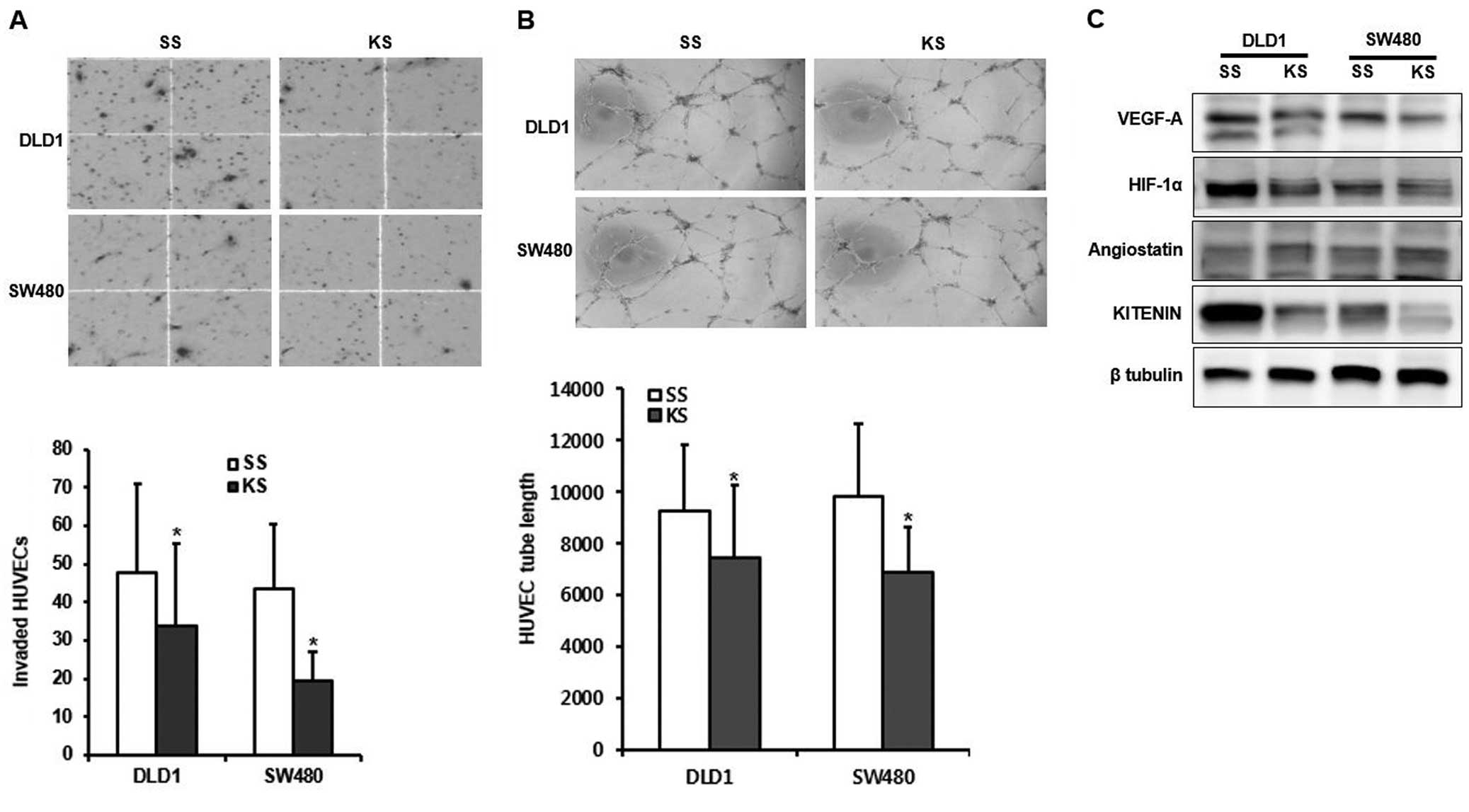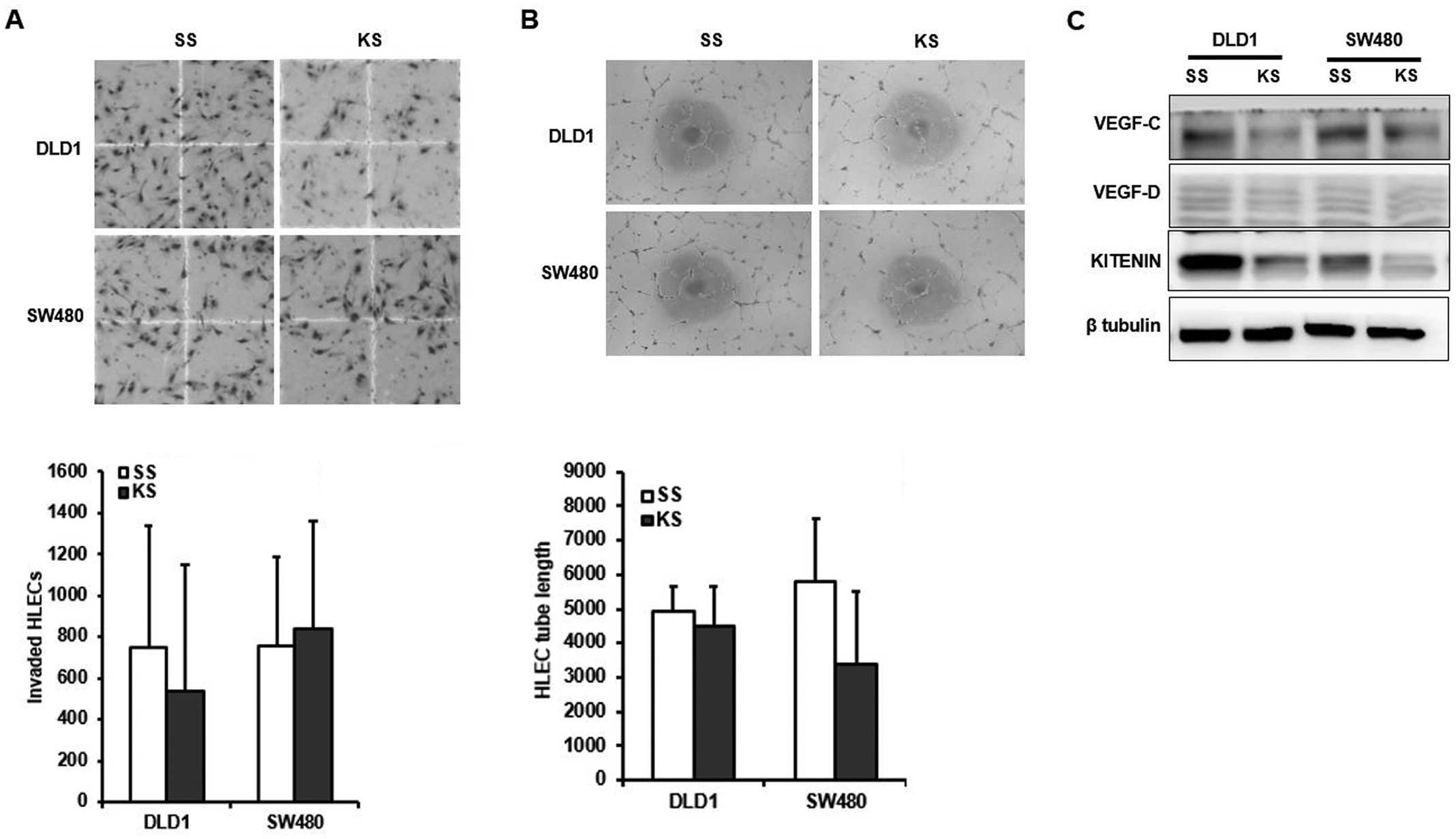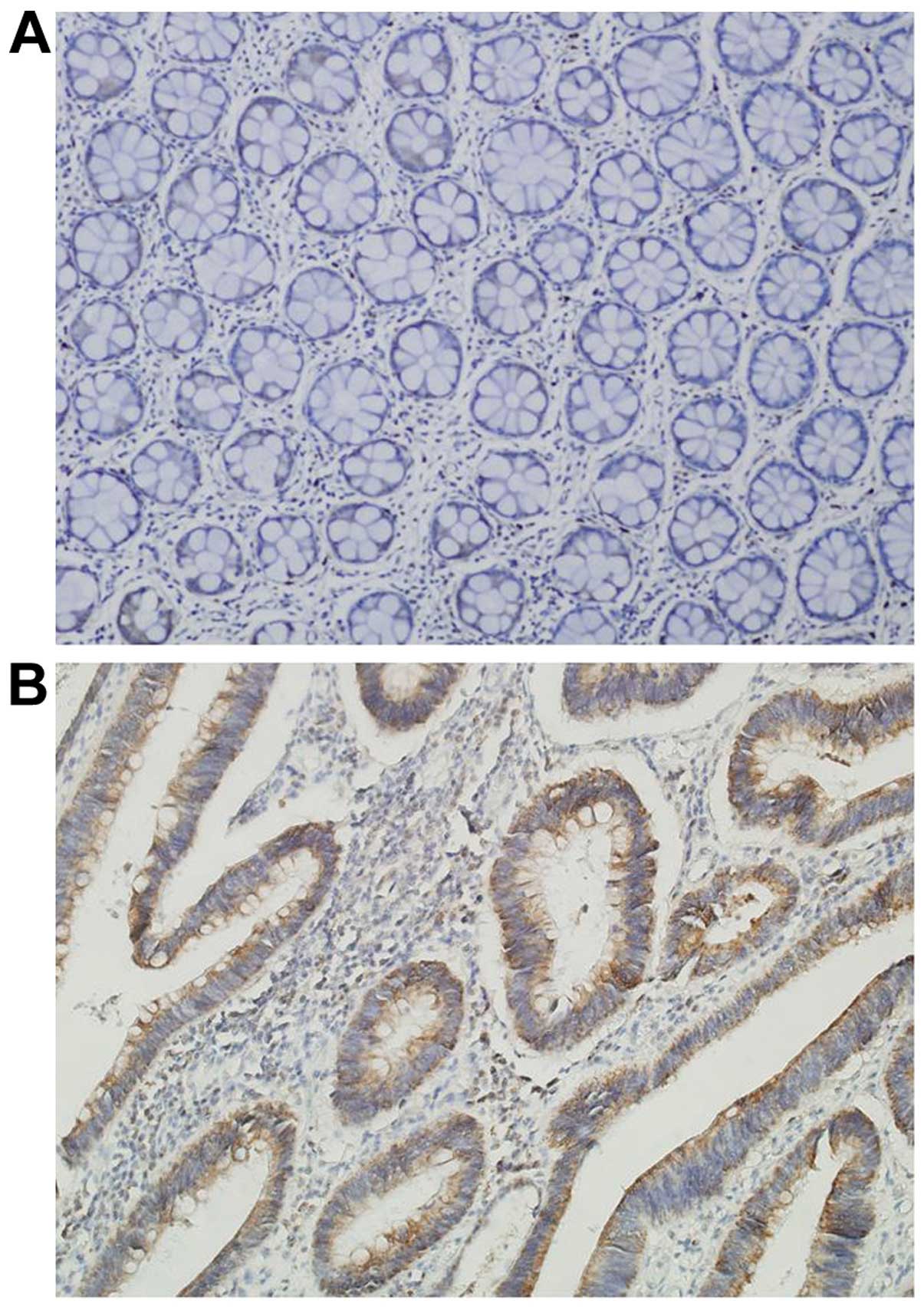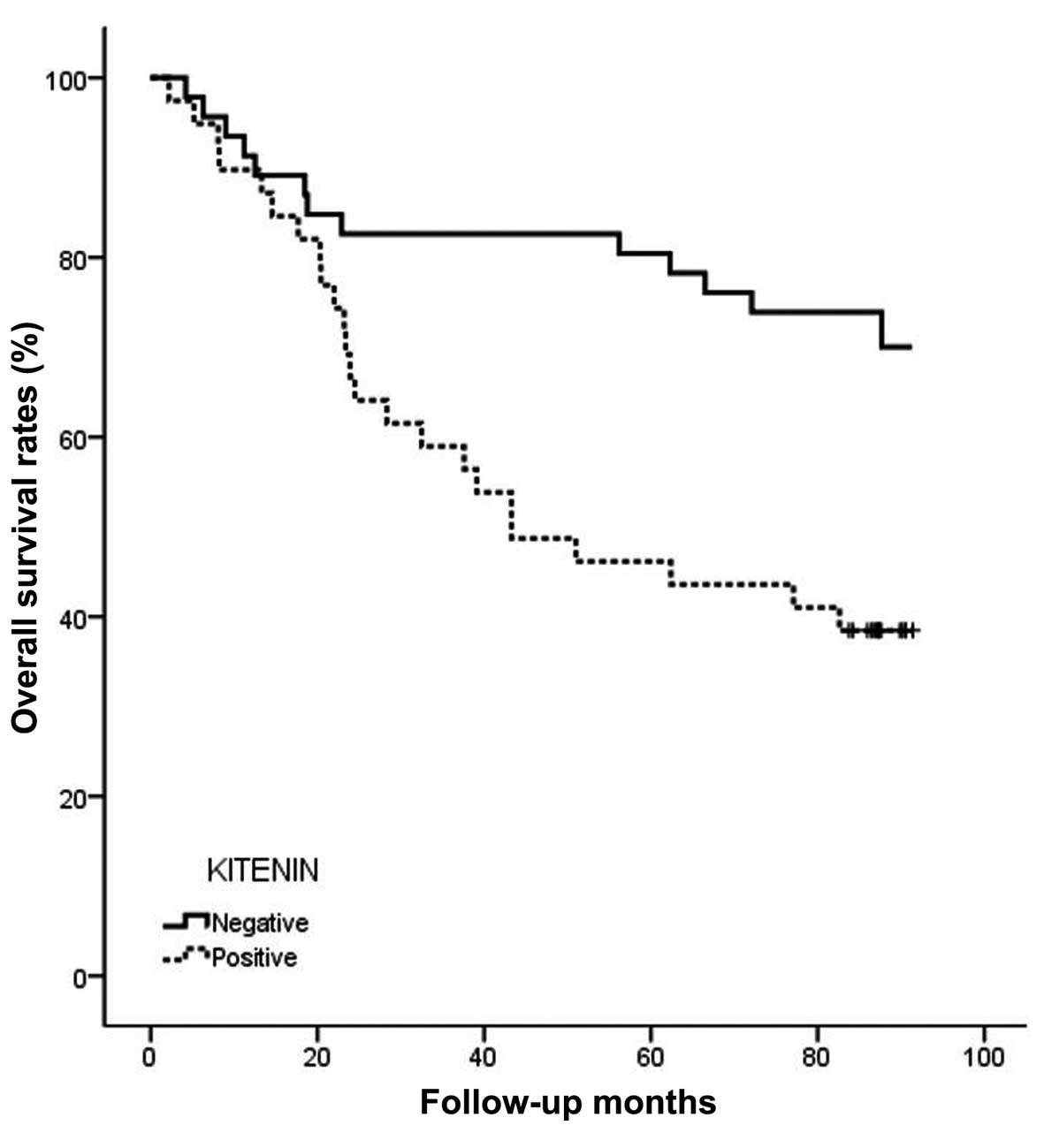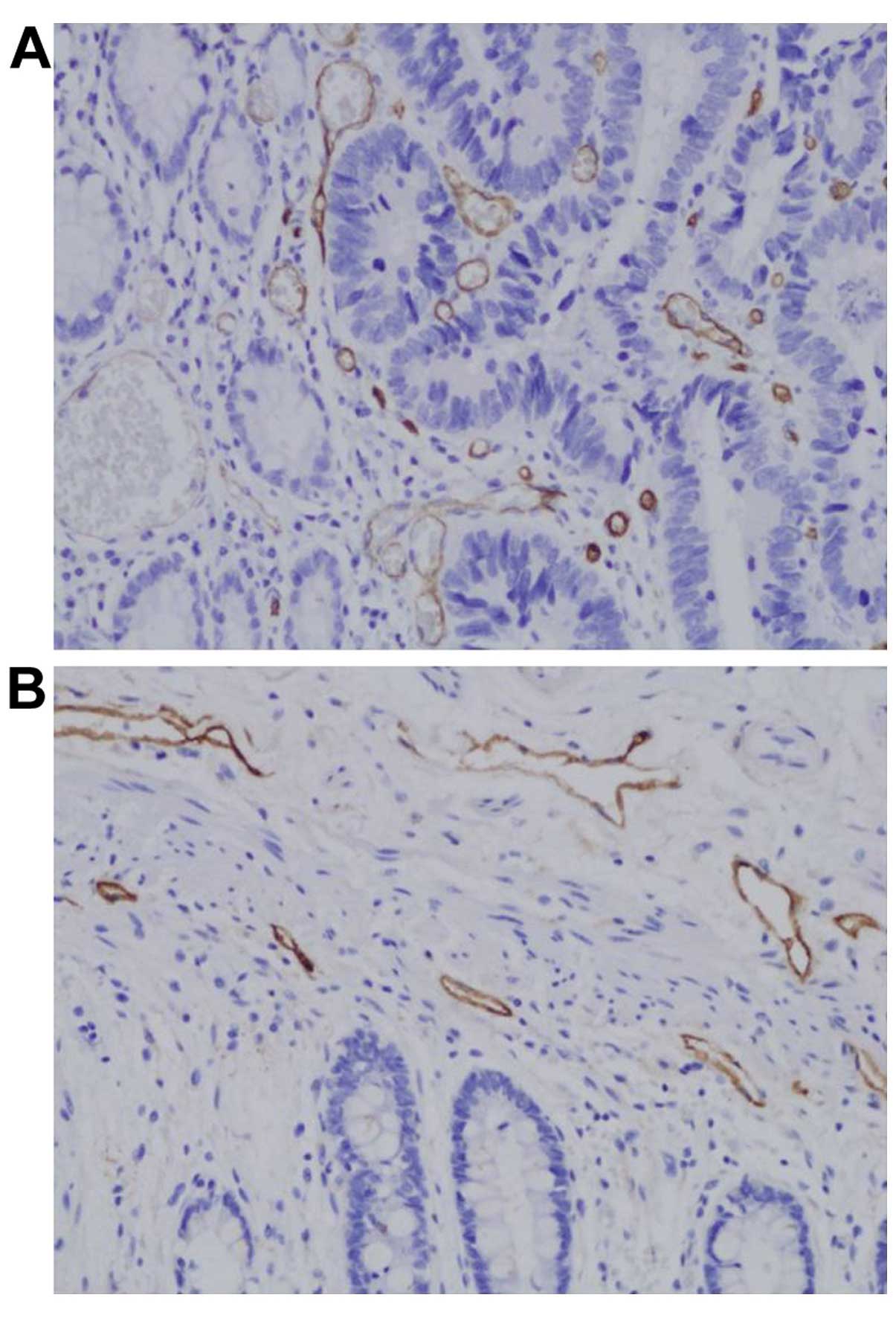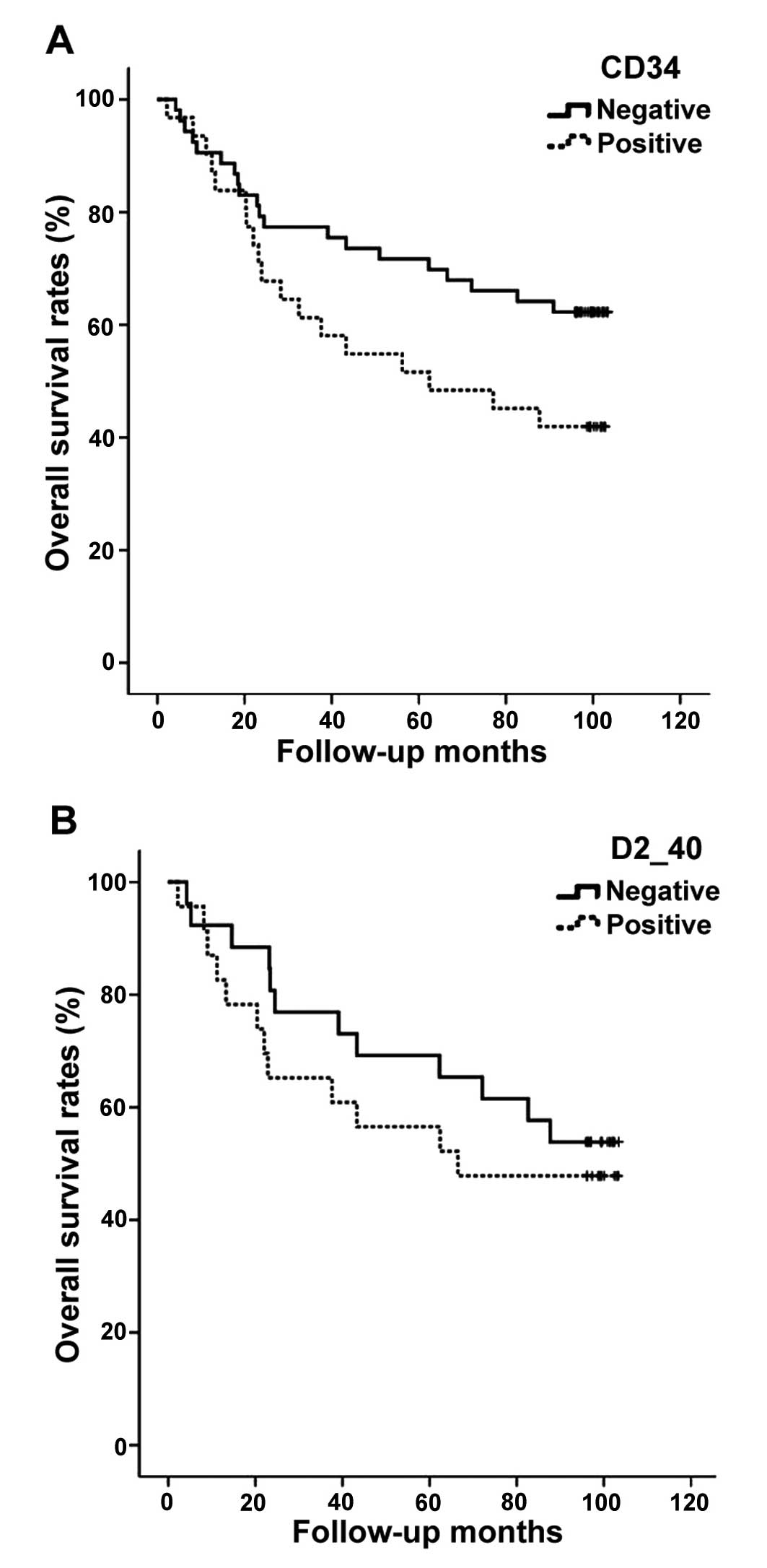Impact of KITENIN on tumor angiogenesis and lymphangiogenesis in colorectal cancer
- Authors:
- Published online on: October 20, 2015 https://doi.org/10.3892/or.2015.4337
- Pages: 253-260
Abstract
Introduction
Colorectal cancer is a leading cause of cancer-related death worldwide (1). Despite improved methods of early diagnosis and treatment, a large proportion of patients with colorectal cancer die from cancer progression including tumor invasion and metastasis (1–3). Cancer progression is an extremely complex process including tumor cell proliferation, invasion, apoptosis, angiogenesis, lymphangiogenesis and metastasis into distant organs or tissues (4–6). Therefore, understanding of the biological and molecular mechanisms involved in colorectal cancer progression is crucial to the development of more effective cancer therapies for preventing cancer progression.
KAI1/CD82 is a member of the tetraspanin family, which is involved in cell motility, and this molecule has been identified as a suppressor of tumor spread (7,8). Numerous previous studies revealed that downregulation or loss of KAI1/CD82 is associated with tumor progression and poor prognosis in many human cancers (9–13).
KAI1 COOH-terminal interacting tetraspanin (KITENIN) was recently identified as a novel KAI1/CD82-binding protein. It interacts specifically with the COOH-terminal region of KAI1/CD82, which is crucial for the impact of KAI1/CD82 on cell motility (14–18). In contrast to KAI1/CD82, previous studies have demonstrated that KITENIN promotes the migration and invasiveness of various types of human cancer cells, and gene silencing of KITENIN via intravenous injection of short interfering RNA inhibited tumor metastasis in a mouse colon cancer model and a syngeneic mouse squamous cell tumor model (14–18). Furthermore, KITENIN expression was found to be associated with cancer progression and poor prognosis in human cancers including colorectal cancer (19–24). These data indicate that KITENIN plays an important role in cancer progression including tumor invasion and metastasis.
Angiogenesis and lymphangiogenesis are crucial for normal growth and development in addition to protective responses such as wound healing and inflammation. However, aberrant angiogenesis and lymphangiogenesis can occur in a variety of pathological settings including tumor growth and dissemination (25–29). Many lines of evidence indicate that the progression of colorectal cancer depends on angiogenesis and lymphangiogenesis (30–33). Therefore, the role of tumor cell-derived factors in the promotion of angiogenesis and lymphangiogenesis has been extensively studied, as these factors are extremely important for understanding cancer progression. However, the potential role of KITENIN in angiogenesis and lymphangiogenesis in colorectal cancer progression has never been investigated.
The aim of the present study was to evaluate whether KITENIN affects tumor angiogenesis and lymphangiogenesis in colorectal cancer.
Materials and methods
Cell culture and siRNA transfection
DLD1 and SW480 human colorectal cancer cell lines were obtained from the American Type Culture Collection (ATCC; Manassas, VA, USA) and were maintained in Dulbecco's modified Eagle's medium (DMEM) (HyClone, Logan, UT, USA) supplemented with 10% fetal bovine serum and antibiotics. Synthesized human KITENIN small interfering RNA (siRNA) (5′-GCUUGGACUUCAGCCUCGUAGUCAA-3′) and scramble siRNA (Qiagen, Germantown, MD, USA) were transfected using Lipofectamine™ RNAiMAX (Invitrogen, Carlsbad, CA, USA) according to the manufacturer's instructions. After transfection for 5 h, the medium was replaced with serum-free DMEM, and the cells were incubated for 24 h. Cells were re-suspended in RIPA buffer, and the supernatant was centrifuged to obtain the conditioned medium (CM), which was used for migration and tube formation assays. Human umbilical vein endothelial cells (HUVECs; Lonza, Walkersville, MD, USA) and human lymphatic endothelial cells (HLECs; ScienCell, San Diego, CA, USA) were grown in EBM™-2 medium supplemented with EGM™-2 SingleQuots™ (Lonza).
Western blot analysis
Equal amounts of total cell lysates were separated by sodium dodecyl sulfate-polyacrylamide gel electrophoresis and transferred to PVDF membranes (Bio-Rad, Hercules, CA, USA), which were incubated with 5% skim milk to block non-specific binding followed by specific primary antibodies in 2% skim milk overnight at 4°C. Specific proteins were detected using horseradish peroxidase-conjugated secondary antibodies (Millipore, Billerica, MA, USA) and visualized using the LAS-4000 luminescent image analyzer (Fujifilm, Tokyo, Japan). The antibodies used in the present study were as follows: anti-human KITENIN (Atlas, Stockholm, Sweden); vascular endothelial growth factor (VEGF)-A, VEGF-C, VEGF-D and β-tubulin (Santa Cruz Biotechnology, Santa Cruz, CA, USA); and hypoxia-inducible factor-1α (HIF-1α) and angiostatin (Abcam, Cambridge, UK).
Matrigel invasion assay
A Transwell filter chamber with 8-µm pores was coated with Matrigel (1 mg/ml; BD Biosciences, San Diego, CA, USA) and was dried at room temperature. HUVECs and HLECs were plated in duplicate at a concentration of 3×104 cells/well with serum-free EGM-2 medium on the upper chamber. The lower chambers were filled with prepared CM. After incubation for 3 h, cells that invaded through the Transwell membrane were stained with Diff-Quik solution (Sysmex, Kobe, Japan) and were counted under a microscope.
In vitro endothelial tube formation assay
Forty-eight-well plates were coated with Matrigel (10 mg/ml) and were incubated at 37°C to promote polymerization. HUVECs and HLECs were re-suspended in CM and were added to each well of the plate which were coated with Matrigel. After 18 h of incubation, fields from each sample were photographed using an inverted microscope, and the total tube length was analyzed using the WimTube image analysis platform (Wimasis GmbH, Munich, Germany).
Patients and tissue samples
For immunohistochemical staining, paraffin-embedded tumor samples from 85 patients who underwent surgery for colorectal cancer at the Chonnam National University Hwasun Hospital (Jeonnam, Korea) between July 2007 and June 2008, were studied. No patient had received preoperative radiotherapy or chemotherapy. Pathologic studies and clinical histories at the time of surgery were reviewed through the medical records. Tumor staging was performed in accordance with the American Joint Committee on Cancer staging system (34). Clinical outcomes were determined from the time of surgery until follow-up on December 31, 2014. The present study was approved by the Institutional Review Board of Chonnam National University Hwasun Hospital. All participants provided written consent for their information to be stored in the hospital database and used for research.
Immunohistochemistry
Paraffin-embedded tissue sections were rehydrated and retrieved with pH 6.0 citrate buffer. Tissue sections were immersed with peroxidase-blocking solution (Dako, Carpinteria, CA, USA) to block endogenous peroxidase activity and incubated with polyclonal rabbit ant-human KITENIN, CD34 (Abcam) and D2-40 (Dako, Glostrup, Denmark) in primary diluent solution (Invitrogen) overnight at 4°C. After washing in TBST, tissues were stained using Dako Real™ EnVision HRP/DAB detection system (Dako). The slides were counterstained with hematoxylin and were then mounted. Stained tissues were viewed and photographed using a light microscope.
Evaluation of KITENIN expression
The immunoreactive score of KITENIN expression was independently evaluated by two pathologists who were blinded to the immunostaining pattern and clinical outcomes. Consensus scores were assigned for each case by reviewing the slides with discrepancies in scoring. The staining intensity was graded on a scale of 0–3 as follows: 0 (no staining), 1 (weak staining), 2 (moderate staining) and 3 (strong staining). The staining area was scored as 0 for no positive staining of tumor cells, 1 for positive staining in <10% of the tumor cells, 2 for positive staining in 10–50% of the tumor cells, and 3 for positive staining in >50% of the tumor cells. The staining index was calculated as the product of the staining intensity and staining area. The tumors were determined to have positive expression (staining index ≥4) or negative expression (staining index <4).
Assessment of microvessel density (MVD) and lymphatic vessel density (LVD)
All scores and interpretations of immunohistochemical results were performed by one examiner without knowledge of the clinical outcomes. MVD and LVD were measured on anti-CD34 and anti-D2-40 antibody-immunoreactive specimens, respectively. Vessel density was evaluated within neoplastic tissues and within healthy tissues outside the tumor. The immunostained sections were scanned at a low magnification of ×40 to identify the areas with the largest amount of vessels (hot spots). In the present study, three hot spots were chosen for each case with agreements of both observers, and five fields were examined in each hot spot at a high magnification of ×200. The average MVD and LVD were expressed as the mean value of vessels.
Statistical analysis
Statistical Package for the Social Sciences (version 15.0; SPSS, Inc., Chicago, IL, USA) was used for statistical analysis. The correlations of clinicopathological factors and recurrence with KITENIN expression, MVD and LVD were assessed using Chi-square and Fisher's exact tests. The survival rates of patients were evaluated according to the Kaplan-Meier method, and the differences were tested using a log-rank test. The subgroups of MVD and LVD were analyzed using a t-test. P<0.05 was considered to indicate a statistically significant result.
Results
Impact of KITENIN silencing on angiogenesis in human colorectal cancer cells
To determine whether CM from KITENIN and scrambled siRNA-transfected colorectal cancer cells affects the invasiveness of HUVECs, we performed a Matrigel invasion assay. The invasiveness of HUVECs was significantly decreased in the CM of KITENIN siRNA-transfected DLD1 and SW480 cells compared to the findings for the scramble siRNA-transfected cells (P=0.031 and 0.015, respectively) (Fig. 1A). Next, we examined whether KITENIN silencing can stimulate endothelial tube formation, which mimics in vivo angiogenesis. CM from KITENIN siRNA-transfected DLD1 and SW480 cells less effectively stimulated tube formation than that from the respective scrambled siRNA-transfected cells (P=0.047 and 0.038, respectively) (Fig. 1B). KITENIN silencing led to decreased expression of the angiogenic inducers VEGF-A and HIF-1α and increased expression of the angiogenic inhibitor angiostatin in both tested cells (Fig. 1C). These results suggested that KITENIN is capable of increasing both endothelial cell invasion and tube formation, key events in angiogenesis and neovascularization.
Impact of KITENIN silencing on lymphangiogenesis in human colorectal cancer cells
To evaluate the effects of KITENIN on lymphangiogenesis in HLECs, we performed Matrigel invasion and tube formation assays using CM from KITENIN and scrambled siRNA-transfected DLD1 and SW480 cells. CM from KITENIN siRNA-transfected DLD1 and SW480 cells did not inhibit invasion (P=0.080 and 0.623, respectively) or tube formation (P=0.235 and 0.112, respectively) compared to that in the respective scrambled siRNA-transfected cells (Fig. 2A and B). KITENIN silencing resulted in decreased expression of the lymphangiogenic inducer VEGF-C, but not VEGF-D in both tested cell lines (Fig. 2C).
Correlations between KITENIN and clinicopathological features in human colorectal cancers
To study the role of KITENIN in human colorectal cancer progression, we investigated the protein expression of KITENIN immunohistochemically in formalin-fixed, paraffin-embedded tissue blocks obtained from 85 patients with colorectal cancer for whom clinicopathological data were available. Survival and the correlations between KITENIN immunostaining and clinicopathological parameters were analyzed. KITENIN immunostaining was non-existent or weak in the normal colorectal mucosa (Fig. 3A). KITENIN immunostaining was predominantly identified in the cytoplasm of cancer cells, and it was not detectable in the tumor stroma (Fig. 3B). The percentage of positive tumor cells and the staining intensity for each sample were recorded. For the 85 patient samples evaluated, positive-KITENIN expression was observed in 39 (45.9%) colorectal cancer tissues (Table I). Immunostaining of KITENIN was significantly associated with tumor stage, depth of invasion, lymph node and distant metastasis (P<0.001, P= 0.004, P<0.001 and P= 0.021, respectively) (Table I). Moreover, overall survival for patients with positive KITENIN immunostaining was significantly lower than the survival of the patients with negative immunostaining (P=0.002) (Fig. 4).
Table ICorrelation between KITENIN expression and the clinicopathological parameters of the colorectal cancer cases. |
Correlation between KITENIN expression and tumor cell angiogenesis or lymphangiogenesis in human colorectal cancers
All tumor samples were subjected to immunostaining for CD34 and D2-40 to identify tumor cell angiogenesis and lymphangiogenesis (Fig. 5A and B). The MVD for the 85 tumors ranged from 23.0 to 429.0 (mean, 115.2±74.7). The mean MVD of KITENIN-positive tumors was 133.4±85.0, which was significantly lower than the value for KITENIN-negative tumors (P= 0.018) (Table II). The LVD for the 85 tumors ranged from 4.0 to 31.3 (mean, 13.7±5.8). There was no significant correlation between KITENIN expression and LVD (P=0.528) (Table II).
Table IICorrelation between KITENIN expression and tumor cell angiogenesis or lymphangiogenesis in the colorectal cancers. |
Correlation between MVD or LVD and clinicopathological features in human colorectal cancers
The correlations between MVD or LVD and clinicopathological parameters are summarized in Table III. When a mean MVD of 115.2 was chosen as the cut-off for discrimination of the 85 patients into two subgroups, 37 patients were determined to have low-MVD, whereas 48 patients had high-MVD. In addition, when a mean LVD of 13.7 was chosen as the cut-off for discrimination of the 85 patients into two subgroups, 39 patients were determined to have low-LVD and 46 patients had high-LVD. No significant correlation was found between MVD or LVD and various clinicopathological parameters (Table III). Moreover, overall survival for patients with high-MVD or LVD was not significantly lower than that for patients with low-MVD or LVD (P=0.073 and 0.492, respectively) (Fig. 6A and B).
Table IIICorrelation between MVD or LVD and clinicopathological parameters of the colorectal cancers. |
Discussion
Angiogenesis is an essential process needed by primary tumors to grow and invade adjacent normal structures (25–27). Angiogenesis is a complex process controlled by a balance of angiogenic and angiostatic factors involved in multiple pathways that result in endothelial cell proliferation, differentiation and organization into a functional network of vascular channels (25–27). In the present study, we investigated the role and mechanisms of KITENIN in promoting angiogenesis. In the present study, KITENIN silencing decreased both endothelial cell migration and tube formation for HUVECs, key events in angiogenesis and neovascularization. In addition, KITENIN silencing resulted in decreased expression of the angiogenic inducers VEGF-A and HIF-1α and increased expression of the angiogenic inhibitor angiostatin in human colorectal cancer cells. These results indicated that KITENIN may play an important role in carcinogenesis by stimulating tumor angiogenesis in concert with angiogenic and angiostatic factors in human colorectal cancer.
Lymphangiogenesis is a dynamic process during embryogenesis that does not occur in normal adult tissue. Indeed, lymphangiogenesis is often activated in the tumor microenvironment (27–29). Malignant tumors induce lymphangiogenesis in primary tumors as well as draining sentinel lymph nodes, thereby promoting lymph node metastasis. The metastatic spread of tumor cells to lymph nodes is enhanced following the induction of tumor lymphangiogenesis, which is driven by lymphangiogenic factors such as VEGF-C and VEGF-D (27–29). In the present study, KITENIN silencing did not decrease either endothelial cell migration or tube formation in HLECs. In addition, KITENIN silencing resulted in decreased expression of the lymphangiogenic inducer VEGF-C, but not VEGF-D, in human colorectal cancer cells. These results suggest that although the expression VEGF-C, one of the central regulators of lymphangiogenesis, was decreased by KITENIN silencing, KITENIN may not be a major factor involved in lymphangiogenesis in colorectal cancer.
Next, we evaluated the expression of KITENIN in a well-defined series of human colorectal cancers, with special reference to patient prognosis. Previously, we reported that KITENIN expression was significantly associated with advanced stage and/or poor survival in various human cancers, including gastric, colorectal, laryngeal and oral cavity cancer, and glioma (20–24). In the present study, KITENIN expression was significantly associated with stage, depth of invasion, lymph node and distant metastasis, and poor survival. These results are in agreement with our previous studies (20–24). Therefore, KITENIN expression plays an important role in tumor progression, and this protein may serve as a potential prognostic factor and target in human colorectal cancer.
The intratumoral MVD as determined by immunohistochemistry is considered to reflect the angiogenic activity generated by neoplastic cells and the supporting stroma (35). Numerous studies have illustrated that increased angiogenesis as measured by MVD was associated with the prognosis of patients with colorectal cancer (36–38). In addition, previously, immunostaining of podoplanin (D2-40) as a molecular marker specific to the lymphatic endothelium has been used to assess lymphangiogenesis in various human cancers (39,40). In the present study, when a mean MVD (or LVD) value was chosen as the cut-off for categorizing the study patients as having low or high-MVD (or LVD), although the MVD and LVD were higher for advanced tumors than for non-advanced tumors, no significant correlation was found between MVD or LVD and various clinicopathological parameters including patient survival. However, many lines of evidence indicate that MVD and LVD are associated with tumor progression and poor prognosis in colorectal cancer (36–38,41–45). These discrepancies may be attributable to the small size of in the present study population, which may have influenced some results, particularly the lack of association for various clinicopathological parameters, and to the different scoring systems and different antibodies used in immunohistochemistry as quantitative markers.
Lastly, we evaluated the correlation between KITENIN expression and tumor cell angiogenesis or lymphangiogenesis in human colorectal cancer tissues to confirm the results of our human colorectal cancer cell line studies. In the present study, the mean MVD of the KITENIN-positive tumors was significantly higher than that of KITENIN-negative tumors. However, the mean LVD of KITENIN-positive tumors was not significantly different from that of KITENIN-negative tumors. These results thus confirm the in vitro findings that KITENIN silencing inhibits angiogenesis.
Taken together, we found that KITENIN is associated with tumor progression by enhancing angiogenesis in colorectal cancer.
References
|
Brenner H, Kloor M and Pox CP: Colorectal cancer. Lancet. 383:1490–1502. 2014. View Article : Google Scholar | |
|
Park SH, Song CW, Kim YB, Kim YS, Chun HR, Lee JH, Seol WJ, Yoon HS, Lee MK, Lee JH, et al: Clinicopathological characteristics of colon cancer diagnosed at primary health care institutions. Intest Res. 12:131–138. 2014. View Article : Google Scholar : PubMed/NCBI | |
|
Lee CK: Clinicopathological characteristics of newly diagnosed colorectal cancers in community gastroenterology practice. Intest Res. 12:87–89. 2014. View Article : Google Scholar : PubMed/NCBI | |
|
Riethdorf S, Wikman H and Pantel K: Review: Biological relevance of disseminated tumor cells in cancer patients. Int J Cancer. 123:1991–2006. 2008. View Article : Google Scholar : PubMed/NCBI | |
|
Chambers AF, Groom AC and MacDonald IC: Dissemination and growth of cancer cells in metastatic sites. Nat Rev Cancer. 2:563–572. 2002. View Article : Google Scholar : PubMed/NCBI | |
|
Kim ER and Kim YH: Clinical application of genetics in management of colorectal cancer. Intest Res. 12:184–193. 2014. View Article : Google Scholar : PubMed/NCBI | |
|
Liu WM and Zhang XA: KAI1/CD82, a tumor metastasis suppressor. Cancer Lett. 240:183–194. 2006. View Article : Google Scholar | |
|
Miranti CK: Controlling cell surface dynamics and signaling: How CD82/KAI1 suppresses metastasis. Cell Signal. 21:196–211. 2009. View Article : Google Scholar | |
|
Guo XZ, Friess H, Di Mola FF, Heinicke JM, Abou-Shady M, Graber HU, Baer HU, Zimmermann A, Korc M and Büchler MW: KAI1, a new metastasis suppressor gene, is reduced in metastatic hepatocellular carcinoma. Hepatology. 28:1481–1488. 1998. View Article : Google Scholar : PubMed/NCBI | |
|
Dong JT, Suzuki H, Pin SS, Bova GS, Schalken JA, Isaacs WB, Barrett JC and Isaacs JT: Down-regulation of the KAI1 metastasis suppressor gene during the progression of human prostatic cancer infrequently involves gene mutation or allelic loss. Cancer Res. 56:4387–4390. 1996.PubMed/NCBI | |
|
Adachi M, Taki T, Ieki Y, Huang CL, Higashiyama M and Miyake M: Correlation of KAI1/CD82 gene expression with good prognosis in patients with non-small cell lung cancer. Cancer Res. 56:1751–1755. 1996.PubMed/NCBI | |
|
Schindl M, Birner P, Breitenecker G and Oberhuber G: Down-regulation of KAI1 metastasis suppressor protein is associated with a dismal prognosis in epithelial ovarian cancer. Gynecol Oncol. 83:244–248. 2001. View Article : Google Scholar : PubMed/NCBI | |
|
Su JS, Arima K, Hasegawa M, Franco OE, Umeda Y, Yanagawa M, Sugimura Y and Kawamura J: Decreased expression of KAI1 metastasis suppressor gene is a recurrence predictor in primary pTa and pT1 urothelial bladder carcinoma. Int J Urol. 11:74–82. 2004. View Article : Google Scholar : PubMed/NCBI | |
|
Lee JH, Seo YW, Park SR, Kim YJ and Kim KK: Expression of a splice variant of KAI1, a tumor metastasis suppressor gene, influences tumor invasion and progression. Cancer Res. 63:7247–7255. 2003.PubMed/NCBI | |
|
Lee JH, Park SR, Chay KO, Seo YW, Kook H, Ahn KY, Kim YJ and Kim KK: KAI1 COOH-terminal interacting tetraspanin (KITENIN), a member of the tetraspanin family, interacts with KAI1, a tumor metastasis suppressor, and enhances metastasis of cancer. Cancer Res. 64:4235–4243. 2004. View Article : Google Scholar : PubMed/NCBI | |
|
Lee JH, Cho ES, Kim MY, Seo YW, Kho DH, Chung IJ, Kook H, Kim NS, Ahn KY and Kim KK: Suppression of progression and metastasis of established colon tumors in mice by intravenous delivery of short interfering RNA targeting KITENIN, a metastasis-enhancing protein. Cancer Res. 65:8993–9003. 2005. View Article : Google Scholar : PubMed/NCBI | |
|
Kho DH, Bae JA, Lee JH, Cho HJ, Cho SH, Lee JH, Seo YW, Ahn KY, Chung IJ and Kim KK: KITENIN recruits Dishevelled/PKC delta to form a functional complex and controls the migration and invasiveness of colorectal cancer cells. Gut. 58:509–519. 2009. View Article : Google Scholar | |
|
Lee JK, Bae JA, Sun EG, Kim HD, Yoon TM, Kim K, Lee JH, Lim SC and Kim KK: KITENIN increases invasion and migration of mouse squamous cancer cells and promotes pulmonary metastasis in a mouse squamous tumor model. FEBS Lett. 583:711–717. 2009. View Article : Google Scholar : PubMed/NCBI | |
|
Cho SB, Park YL, Park SJ, Park SY, Lee WS, Park CH, Choi SK, Heo YH, Koh YS, Cho CK, et al: KITENIN is associated with activation of AP-1 target genes via MAPK cascades signaling in human hepatocellular carcinoma progression. Oncol Res. 19:115–123. 2011. View Article : Google Scholar : PubMed/NCBI | |
|
Ryu HS, Park YL, Park SJ, Lee JH, Cho SB, Lee WS, Chung IJ, Kim KK, Lee KH, Kweon SS, et al: KITENIN is associated with tumor progression in human gastric cancer. Anticancer Res. 30:3479–3486. 2010.PubMed/NCBI | |
|
Lee S, Song YA, Park YL, Cho SB, Lee WS, Lee JH, Chung IJ, Kim KK, Rew JS and Joo YE: Expression of KITENIN in human colorectal cancer and its relation to tumor behavior and progression. Pathol Int. 61:210–220. 2011. View Article : Google Scholar : PubMed/NCBI | |
|
Lee JK, Yoon TM, Seo DJ, Sun EG, Bae JA, Lim SC, Choi YD, Lee JH, Joo YE and Kim KK: KAI1 COOH-terminal interacting tetraspanin (KITENIN) expression in early and advanced laryngeal cancer. Laryngoscope. 120:953–958. 2010.PubMed/NCBI | |
|
Yoon TM, Kim SA, Lee JK, Park YL, Kim GY, Joo YE, Lee JH, Kim KK and Lim SC: Expression of KITENIN and its association with tumor progression in oral squamous cell carcinoma. Auris Nasus Larynx. 40:222–226. 2013. View Article : Google Scholar | |
|
Lee KH, Ahn EJ, Oh SJ, Kim O, Joo YE, Bae JA, Yoon S, Ryu HH, Jung S, Kim KK, et al: KITENIN promotes glioma invasiveness and progression, associated with the induction of EMT and stemness markers. Oncotarget. 6:3240–3253. 2015. View Article : Google Scholar : PubMed/NCBI | |
|
Mittal K, Ebos J and Rini B: Angiogenesis and the tumor micro-environment: Vascular endothelial growth factor and beyond. Semin Oncol. 41:235–251. 2014. View Article : Google Scholar : PubMed/NCBI | |
|
Zhao Y and Adjei AA: Targeting angiogenesis in cancer therapy: Moving beyond vascular endothelial growth gactor. Oncologist. 20:660–673. 2015. View Article : Google Scholar : PubMed/NCBI | |
|
Gomes FG, Nedel F, Alves AM, Nör JE and Tarquinio SB: Tumor angiogenesis and lymphangiogenesis: Tumor/endothelial crosstalk and cellular/microenvironmental signaling mechanisms. Life Sci. 92:101–107. 2013. View Article : Google Scholar : | |
|
Stacker SA, Williams SP, Karnezis T, Shayan R, Fox SB and Achen MG: Lymphangiogenesis and lymphatic vessel remodelling in cancer. Nat Rev Cancer. 14:159–172. 2014. View Article : Google Scholar : PubMed/NCBI | |
|
Duong T, Koopman P and Francois M: Tumor lymphangiogenesis as a potential therapeutic target. J Oncol. 2012:2049462012. View Article : Google Scholar : PubMed/NCBI | |
|
Weng W, Feng J, Qin H and Ma Y: Molecular therapy of colorectal cancer: Progress and future directions. Int J Cancer. 136:493–502. 2015. | |
|
Marques I, Araújo A and de Mello RA: Anti-angiogenic therapies for metastatic colorectal cancer: Current and future perspectives. World J Gastroenterol. 19:7955–7971. 2013. View Article : Google Scholar : PubMed/NCBI | |
|
Royston D and Jackson DG: Mechanisms of lymphatic metastasis in human colorectal adenocarcinoma. J Pathol. 217:608–619. 2009. View Article : Google Scholar : PubMed/NCBI | |
|
Sun XF and Zhang H: Clinicopathological significance of stromal variables: Angiogenesis, lymphangiogenesis, inflammatory infiltration, MMP and PINCH in colorectal carcinomas. Mol Cancer. 5:432006. View Article : Google Scholar : PubMed/NCBI | |
|
American Joint Committee on Cancer Classification (AJCC): Cancer Staging Manual. 6 edition. revised. Lippincott-Raven; Philadelphia: pp. 113–123. 2002 | |
|
Weider N, Semple JP, Welch WR and Folkman J: Tumor angiogenesis and metastasis - correlation in invasive breast carcinoma. N Engl J Med. 324:1–8. 1991. View Article : Google Scholar | |
|
Takahashi Y, Kitadai Y, Bucana CD, Cleary KR and Ellis LM: Expression of vascular endothelial growth factor and its receptor, KDR, correlates with vascularity, metastasis, and proliferation of human colon cancer. Cancer Res. 55:3964–3968. 1995.PubMed/NCBI | |
|
Svagzdys S, Lesauskaite V, Pavalkis D, Nedzelskiene I, Pranys D and Tamelis A: Microvessel density as new prognostic marker after radiotherapy in rectal cancer. BMC Cancer. 9:952009. View Article : Google Scholar : PubMed/NCBI | |
|
Des Guetz G, Uzzan B, Nicolas P, Cucherat M, Morere JF, Benamouzig R, Breau JL and Perret GY: Microvessel density and VEGF expression are prognostic factors in colorectal cancer. Meta-analysis of the literature. Br J Cancer. 94:1823–1832. 2006. View Article : Google Scholar : PubMed/NCBI | |
|
Donizy P, Rudno-Rudzinska J, Halon A, Dziegala M, Kabarowski J, Frejlich E, Dziegiel P, Kielan W and Matkowski R: Intratumoral but not peritumoral lymphatic vessel density measured by D2-40 expression predicts poor outcome in gastric cancer - ROC curve analysis to find cut-off point. Anticancer Res. 34:3113–3118. 2014.PubMed/NCBI | |
|
Pula B, Wojnar A, Witkiewicz W, Dziegiel P and Podhorska-Okolow M: Podoplanin expression in cancer-associated fibroblasts correlates with VEGF-C expression in cancer cells of invasive ductal breast carcinoma. Neoplasma. 60:516–524. 2013. View Article : Google Scholar : PubMed/NCBI | |
|
Gao J, Knutsen A, Arbman G, Carstensen J, Frånlund B and Sun XF: Clinical and biological significance of angiogenesis and lymphangiogenesis in colorectal cancer. Dig Liver Dis. 41:116–122. 2009. View Article : Google Scholar | |
|
Sundov Z, Tomic S, Alfirevic S, Sundov A, Capkun V, Nincevic Z, Nincevic J, Kunac N, Kontic M, Poljak N, et al: Prognostic value of MVD, LVD and vascular invasion in lymph node-negative colon cancer. Hepatogastroenterology. 60:432–438. 2013.PubMed/NCBI | |
|
Yan G, Zhou XY, Cai SJ, Zhang GH, Peng JJ and Du X: Lymph-angiogenic and angiogenic microvessel density in human primary sporadic colorectal carcinoma. World J Gastroenterol. 14:101–107. 2008. View Article : Google Scholar : PubMed/NCBI | |
|
Holmqvist A, Gao J, Adell G, Carstensen J and Sun XF: The location of lymphangiogenesis is an independent prognostic factor in rectal cancers with or without preoperative radiotherapy. Ann Oncol. 21:512–517. 2010. View Article : Google Scholar | |
|
Jakob C, Aust DE, Liebscher B, Baretton GB, Datta K and Muders MH: Lymphangiogenesis in regional lymph nodes is an independent prognostic marker in rectal cancer patients after neoadjuvant treatment. PLoS One. 6:e274022011. View Article : Google Scholar : PubMed/NCBI |



